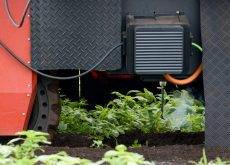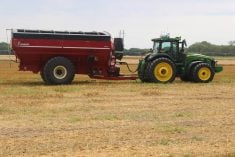Canola Watch, published by the Canola Council of Canada, has published tips on broadcast seeding of canola. The tips are based on experience, observation and limited research. There has been no concerted broadcast research, so official recommendations do not exist.
The following points have been edited from a Canola Watch posting.
1. Timing
Manitoba crop insurance data shows canola seeded in the first week of June yields 90 percent of average. If early June broadcast appears to be the best solution, warmer soil should assist rapid germination and establishment of the seedlings with less risk of mortality from cool soils or frost damage.
Read Also

Research looks to control flea beetles with RNAi
A Vancouver agri-tech company wants to give canola growers another weapon in the never-ending battle against flea beetles.
2. Seeding rate
Seed germination and seedling survival could be lower than for seed drilled into a moist, packed seedbed, but not necessarily. In the Ultimate Canola Challenge site in Manitoba in 2013, one team of experts chose to broadcast onto moist, warm soil, with exceptional survival.
With a seeding rate of 10 seeds per sq. foot, low emergence of 20 percent will result in two plants per sq. foot. A related study found an established uniform canola stand with as few as two plants per sq. foot generally had higher economic potential than a thicker stand reseeded late. If emergence is 80 percent, the population will be at the top end of recommended target of five to eight plants per sq. foot. This higher plant population has the benefit of earlier maturity.
3. Equipment
Floaters and Valmar applicators have a 60- or 70-foot boom that can be used to broadcast canola. Some applicators have multiple compartments, each with their own meters, to apply fertilizer and seed at the same time. Another option is a regular air drill with openers lifted out of the ground.
4. Fertilizer
A good-yielding crop needs fertilizer. Some take a chance and skip fertilizer, hoping to bank on a decent supply from soil reserves, but that hope rarely turns out well.
- Apply the recommended rate of phosphorus. The starter rate of phosphorus is not enough. Use the full recommended rate when broadcasting. Canola with phosphorus often gets off to a quicker start, which can reduce days to maturity.
- Use urease and nitrification inhibitors. Broadcast nitrogen has a higher risk of loss when applied on moist soils. Combination products with urease and nitrification inhibitors are a good choice to protect the nitrogen in this situation.
- Consider a slightly lower than recommended nitrogen rate, 85 to 90 percent of soil test recommendation for canola broadcast in late May or early June. The full rate of nitrogen could extend the required days to maturity.
- Seed soon after blending. When seed and fertilizer are blended days prior to application, fertilizer could reduce canola seed viability.
- John Heard tested germination after blending with fertilizer. A day or two showed no significant effect on germination, but ammonium sulphate was particularly damaging when left longer.
- Fertilizer prills are abrasive and can remove some canola seed treatment. Ammonium sulphate blended with canola seed will often take on a blue tint, indicating a high rate of abrasion. Ammonium sulphate also has an affinity for moisture and can increase plugging in humid conditions. One benefit of blending phosphorus or urea with canola is that it bulks up the canola, thus making application less finicky.
- Consider a split fertilizer application. Broadcast seed first, then top up with appropriate nitrogen and sulphur if the crop establishes. Early access to nutrient is important for optimal yields, so top-dressing applications should be made as soon as possible after emergence.
- Broadcast nitrogen and sulphur first, then drill your seed. If the key barrier to using the drill is getting stuck pulling a fully-loaded cart, growers can broadcast nitrogen and sulphur, and use the drill just for seed and phosphorus. They won’t have to fill the seeder tank right full, which allows the drill into a field without getting stuck.
- Ammonium sulphate is particularly hard on canola seed germination when mixed and left for three or more days.
5. Residue risk
Broadcast seeding requires good seed-to-soil contact. A thick layer of thatch prevents seed and fertilizer from getting down to the soil surface. Cultivating ahead of broadcasting can create large clods and crusted soil surface.
6. Cultivate or harrow after seeding
Shallow cultivation or harrowing improves seed-to-soil contact. The ideal harrowing pass will run on a right angle to the floater pass. Therefore, harrow after the floater leaves the field, rather than chase the floater around the field.
7. Airplane or helicopter
If a field is too wet for a floater, it’s too wet for harrows and sprayers. Fields should be harrowed after broadcast seeding to loosen the soil surface and provide seed to soil contact, especially for seed broadcast onto stubble. Canola seed is very light and does not embed into the soil, even if dropped from an airplane at high speed. Aerial seeding also requires ground-based fertilizer application. The critical time for fertilizer application is within five weeks of crop emergence.
8. Weed control caution
Seeds on the soil surface are vulnerable to herbicide damage. Do not apply post-seed/pre-emergence glyphosate on Liberty Link and Clearfield seeds that have been broadcast and remain on the soil surface. Roundup Ready varieties can tolerate glyphosate at this early stage.
- Yield expectations — Experience from 2010 and 2011 in wet conditions in the eastern Prairies has shown that growers who tried broadcast or aerial methods had issues all season with thin stands, uneven maturity, weed control, low fertility and poor yields. Best results were on fields that were fertilized early and harrowed to improve seed-to-soil contact. If field conditions allow for follow-up passes to harrow and apply fertilizer, it means the fields could also soon be ready to seed with the drill.
- Regis Karamanos compared broadcast and row-seeded canola at six sites from 1997 to 1999. He concluded row-seeding had a significant yield advantage up to 0.58 tonnes per hectare in four of the six experiments and no significant difference at the other two. The yield advantage for row-seeded canola at the four sites was from three to 10 bu. per acre based on canola yielding around 50 bu. per acre. A 1977 study compared broadcast and drilled canola head-to-head. Drilled canola had a yield advantage, but broadcast results were still pretty good.


















